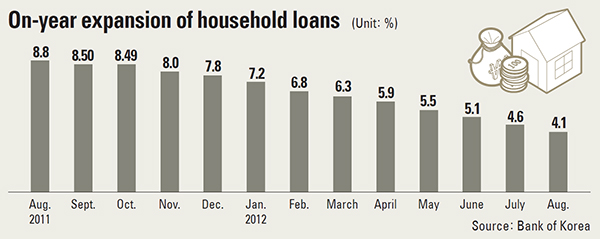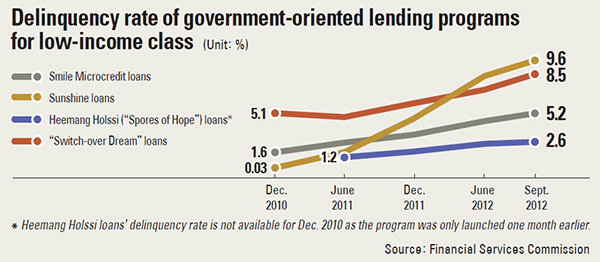Household loan growth eases but quality sours

Household loans extended by financial companies grew at the lowest pace ever on-year in August, but such debt among low-class borrowers is badly structured and delinquency rates for government-initiated low-interest loans have shot up, financial authorities said yesterday.
According to data by the Bank of Korea, household loans given out by local banks and non-banking institutions stood at 649.8 trillion won ($597.2 billion) in August, up 4.1 percent on-year, indicating that the domestic property market remains sluggish due to the global economic slowdown triggered by the euro zone debt crisis and looming fiscal cliff in the United States.
The central bank said the August growth rate was the lowest tallied since data was first compiled in October 2003. BOK officials forecast that it is just a matter of time before growth dwindles to the 3-percent range.
The annualized monthly growth rate of household loans has hovered between 6 and 9 percent since 2003, the central bank said.
When Korea was still recovering from the global economic crisis in August 2011, growth surged 8.8 percent, it added.
Market observers cited low demand for mortgages due to the frozen real estate market as the biggest factor contributing to the shrinking loans.
“The government’s measures to curb household debt have made it more difficult for people to borrow despite their deteriorating economic conditions,” said Park Deok-bae, a research fellow at Hyundai Economic Research Institute.
“The decline in total household debt may look like we’re heading in the right direction but there is concern that those who are strapped for cash are simply migrating over to loan sharks.”

Meanwhile, delinquency rates at four government-oriented low-interest lending programs - Smile Microcredit, Switch-over Dream, Sunshine and Heemang Holssi (Spores of Hope) loans - have soared amid escalating uncertainty in the global economy, according to data released by the Financial Services Commission (FSC) yesterday.
Among the four low-interest loan programs that are designed to help people with low credit ratings, Sunshine loans recorded the highest default ratio in the third quarter of 9.6 percent, up 1.2 percentage point from Q2. It was followed by Switch-over Dream loans (8.5 percent), Smile Microcredit loans (5.2 percent) and Heemang Holssi loans (2.6 percent)
The FSC said the default ratio of low-interest loans could continue to go up due to the sluggish economy but that the risk was manageable.
“The delinquency ratio of low-interest rate loans is lower than that of household loans from savings banks, which stands at around 11.3 percent,” an official at the FSC said.
The FSC said a total of 810,000 people with low credit ratings have taken out a combined 7.3 trillion won from the government-initiated loan programs since Smile Microcredit loans debuted in 2008.
By Kim Mi-ju [mijukim@joongang.co.kr]










with the Korea JoongAng Daily
To write comments, please log in to one of the accounts.
Standards Board Policy (0/250자)